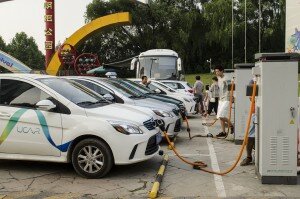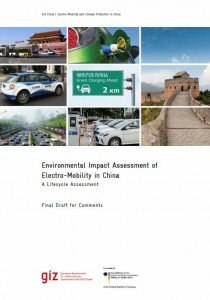Monetary purchasing subsidies, super credits, tax exemptions and local incentives for industry and consumers: China is sparing no efforts in its drive towards market expansion for e-mobility. The motives of China’s industrial policy are straightforward, yet environmental protection as a driver is not equally unambiguous. Prevalent coal-fired electricity production is sparking doubts whether an electrification of motorised individual mobility has a positive impact on the climate. A Sino-German cooperation project addresses these issues by assessing the environmental impact of electric vehicles in China.
As an important economic driver in China, the automotive sector is a significant provider of employment and shapes technological innovation. It has significantly contributed to China’s unprecedented economic growth over the past decades. Conversely, daunting climate and environmental concerns have cast a shadow on this development. Air pollution, noise, accidents, congestion – the list of very tangible, negative external effects of transport is long. Less perceptible, but significant effects are the greenhouse gas emissions released as a result of internal combustion engines burning fossil fuels. The associated negative social, environmental and climatic impacts create a real dilemma: Implementing environmental policies in the transport sector that are conducive to trade, personal mobility and economic development while circumventing negative external effects such as climate change, is a challenging yet inescapable mission for Chinese policy makers. With its 12th five-year plan (2011-2015), the Chinese Government identified the promotion of electric vehicles (EV) as a key to address this challenge.
To what extent EVs alleviate the environmentally harmful effects of motorised transport depends on a number of influencing factors. When driven (in purely electric mode), EVs produce neither air pollutants nor greenhouse gases at the tailpipe. The environmental impacts of EVs really depend on upstream emissions such as the emissions during electricity production as well as the vehicle manufacturing and recycling process.
The best (LCA) tool and dataset that is available in China was applied in a joint study by GIZ and the renowned Tsinghua University to look into this question. The model compares the energy consumption, greenhouse gas and critical air pollutant emissions of various types of EVs with conventional gasoline vehicles. The study shows that substantial CO2 mitigation effects occur from 2020 onwards. By 2030 propulsion technologies could save between 40 and 47 million tonnes of CO2. Beyond that, various air pollutants were analysed in the study. EV promotion reduces volatile organic compound and carbon monoxide emissions, but may increase nitrogen oxide, sulphur dioxide and PM2.5 emissions significantly.
The LCA results show: Promoting e-mobility is not a low-hanging fruit in the battle against climate change. The long-term mitigation potential of EVs could come at significant abatement and environmental costs today. Nonetheless the LCA also shows that a low-carbon automotive sector is not attainable without EVs.
A discussion on the key results of the environmental impact assessment by Frederik Strompen, Christian Hochfeld and Prof. Wu Ye was published in the Journal “International Transport”, Issue 2, October 2015.
Free Download here
The comprehensive environmental impact assessment can be downloaded here.
The project is funded by the German Federal Ministry for the Environment through its International Climate Initiative and implemented by the Deutsche Gesellschaft für Internationale Zusammenarbeit (GIZ) GmbH and Tsinghua University.
Contact:
Frederik Strompen, , Project Manager
Christian Hochfeld, , Senior Advisor Sustainable Transport





